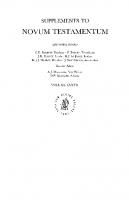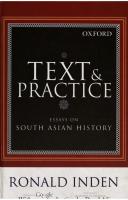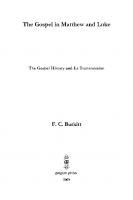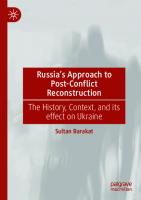The Didache in Context: Essays on Its Text, History, and Transmission 9004100458, 9789004100459
The Didache in Context contains an intriguing look into the background of the Didache, exploring the influence of the te
130 51
English Pages 440 [441] Year 1994
THE DIDACHE IN CONTEXT
Copyright Page
Table of Contents
Introduction
Abbreviations
I. TEXT
The Didache: An English Translation
Der Didachist und seine Quellen
The Text of the Didache: Some Comments on the Edition of Klaus Wengst
Considerations on the Coptic Papyrus of the Didache (British Library Oriental Manuscript 9271)
The Transformation of Moral Exhortation in Didache 1-5
La Didachè et le problème synoptique
The Saving Efficacy of the Burning Process in Didache 16.5
The Curse that Saves (Didache 16.5)
Style-Switching in the Didache: Fingerprint or Argument?
II. HISTORY AND TRANSMISSION
The Hebrew Epic and the Didache
Baptism in the Didache
The Sacred Food of Didache 9-10 and Second-Century Ecclesiologies
Social Ambiguity and the Production of Text: Prophets, Teachers, Bishops, and Deacons and the Development of the Jesus Tradition in the Community of the Didache
Didache 11-13: The Legacy of Radical Itinerancy in Early Christianity
Did Ignatius of Antioch Know the Didache?
The Didache and Early Monasticism in the East and West
A Bibliography of Literature on the Didache
Works Cited
Indices
Plates
Recommend Papers

- Author / Uploaded
- Clayton N. Jefford (editor)
File loading please wait...
Citation preview
THE DIDACHE IN CONTEXT
SUPPLEMENTS TO
NOVUM TESTAMENTUM EDITORIAL BOARD
C.K. BARRETT, Durharn - P. BORGEN, Trondheim ].K. ELLIOTT, Leeds - H.]. DEJONGE, Leiden M.].]. MENKEN, Heerlen -]. SMIT SIBINGA, Amsterdam Executive Editors A.J. MALHERBE, New Haven D.P. MOESSNER, Atlanta
VOLUME LXXVII
.;;;;,~.~f.G/{)~ '"
..0
7'
d:. .....
?
r-
I
~ . I 6 8'" .
,...
..:),.
"
THE DIDACHE IN CONTEXT Essays on Its Text, History and Transmission
EDITED BY
CLAYTON N.JEFFORD
'::::'~I1~f.GI[)t' ..,
.-a(ovEla, acjJoßia Audet. üos, a>-a(ovEla, ou cjJOß01)iJ.EVOL TOV 8EOV corY. Wengst. Niederwimmer, "Textprobleme," S. 123; Niederwimmer, Didache, S. 149 u. Anm. 14. 21 Das folgende (6,2f.) hat keine Parallele mehr im Traktat (Barn. Doctr. Can. Epit. Vita Sehen. Synt.Doctr. Fides patr.). Die Rezension des Traktats, von der Didache und Doctrina abhängig sind, bot 6, I. Der Didachist hat das folgende, den Rest des Epilogs, weggebrochen und durch 6,2f. ersetzt. Der ganze Epilog lautet in Doctrina: (5,2 fin.) Abstine te, fili, ab istis omnibus. (6,1) Et uide, ne quis te ab hac doctrina auocet, et si minus extra disciplinam doceberis. (6,4) Haec in consulendo si cottidie ficeris, prope eris uiuo deo; quod si non ficeris, longe eris a uerilate. (6,5) Haec omnia tibi in animo pone et non deceperis de spe tua, sed per haec sancta cerlamina peruenies ad coronam.
DER DIDACHIST UND SEINE QUELLEN
29
II
DIE AGENDE
1. Über die Taufe
AG (D)
(7,1) I1EPL OE TOU ßaTTTlGflaTOS, OÜTW ßa'ITTLGaTE' mvm TTavm TTPOEL TTOVTES', ßaTTTLaaTE Eis TO ovofla TOU
'ITaTpOS KaL TOU uLou KaL TOU aYLou 'ITVElJflaTOS EV üoaTL (WVTL.
(2) EaV OE fLr] EX7]S' ü8wp (wv, EiS' dUo üowp ßaTTTwov' cl 0' ov ovva(JaL E-V I/lvxP0, E-V eEp/10. (3) E-elV OE awp6TEpa /1r] EX7]S', EKXEOV EiS' Tr]V KEcpaAr]v TptS' üowp EiS' ovo/1a TTaTpaS' Kat VLOV Kat aYLOV TTVEV/1aTOS'. AG (4) 'ITPO OE TOU ßa'ITTLGflaTOS 'ITPOVT)GTEUaclTW 0 ßa'ITTL(wv KaL 0 ßa'ITTl(oflEVOS KaL c'L TlVES äAA.Ol OUVaVTaL' D KEAEVELS'22 oE- V7](JTEV(JaL Tav ßaTTTL(O/1E/JOV TTpa /1[(1S' f] oVo. D
la. Über Fasten und Beten
AG
a) Über das rechte Fasten (8,1) AL OE VT)GTELaL VflwV flT) EGTWGaV flETa TWV V'ITOKPLTWV.
VT)GTEUOUGl yap OEUTEpq GaßßaTwv KaL 'ITEfl'ITTD' VflELS OE VT)GTEUGaTE TETpaoa KaL 'ITapaGKEuf]v.
b) Über das rechte Beten AG (8,2) MT)oE 'ITpoGEuXEa8E ws oL V'ITOKPl Tal, aAA.' (D) WS' hOEV(JEV 0 KVPLOS' E-V T0 EvaYYEALep avTOv, oihw 'ITPOGEUXEa8E' I1(lTEP T)flwV 0 EV T0 oupav0, aYWG8f]TW TO OVOflcl GOU, ü8üw T) ßaO"lAda GOU, YEVT)8f]TW 23 TO 8EAT)flcl GOU ws EV oupav0 KaL E'ITL YllS' TOV äPTOV T)flWV TOV ETIlOUGlOV 80s T)flLV aT]flEPOV, KaL äES T)flLV TT)V 6ElAT)V T)flwV, wS KaL T)flElS aLEflEV TOLS 6ElAETaLS T)flwv,
So oder so ähnlich hat der ursprüngliche Epilog des Traktats in der von mir sogenannten Rezension C I (dazu Niederwimmer, Didache, S. 63) gelautet. Er hat in Doctrina später einen christlichen Zusatz (epilogus secundus) erhalten. Zum ganzen: Niederwimmer, Didache, S. 152-53. 22 KEAEVElS H. Harnack, Bihlmeyer, Audet, Rordorf-Tuilier. KEAEVCJElS emend. Bryennios, Wengst. 23 'YEVV1l~TLtl H. 'YEV1l~TW emend. Bryennios.
30
KURT NIEDERWIMMER
KaL 1lT) ELGEVEYKl]S iJllClS ElS TTElpaGIlOV, aAAa pVGm iJllClS aTTa TOV TTOVTJpOV' ÖTL GOV EGTLV iJ 8vVallLS KaL iJ 8o~a ElS TOUS aLwvas. (3) Tpis TllS iJllEpas OVTW TT pOGE vXEa8E .
2. Über die Mahifeier a) Gebete zum Sättigungsmahl AG (9,1) TIEPL 8E TTlS EuxapwTLas, OVTWS EUxapWTIjO"aTc (2) TTPWTOV TTEPL TOV TTOTllPLOU' EuXapWTovllEV GüL, mlTEp iJllwv, {JTTEP TllS aYLas allTTEAou LlauL8 TOV TTm80s GOU, ~S Eyvwpwas iJlllv 8La 'ITjGOV TOV TTm80s GOU' GOL iJ 8o~a ElS TOUS aLwvas. (3) TIEPL 8E TOV ÜpTOU· 24 EuXapWTovllEV GüL, mlTEp iJllwv, {JTTEP TllS (WTlS KaL YVWGEWS, ~S EyvwpLGas iJlllv 8La 'ITjGOV TOV TTm80s GOU' GOL iJ 8o~a ElS TOUS aLwvas. (4) WGTTEp ~v TOVTO 8LEaKOpmGIlEVOV 25 Emlvw TWV OPEWV KaL Gvvax8Ev EYEVETO EV, OVTW GVVaX81lTW GOU iJ EKKATjGLa aTTa TWV TTEPClTWV TllS YTlS ELS TT)V aT)V ßaO"LAElav' ÖTL GOV EGTLV iJ 8o~a KaL iJ 8vvallLS 8La 'ITjGOV XPWTOV ElS TOUS atwvas. D (5) MTJOcLS' OE H. Bryennios, Hamack, Bihlmeyer, Audet, Rordorf-Tuilier. äPTOU cory. Peterson, "Meris," S. 99-100; Peterson, "Probleme," S. 16869; Vööbus, S. 88-89.146-48; Niederwimmer, "Textprobleme," S. 124-25; Niederwimmer, Didache, S. 185-86; Wengst, S. 78.97-98. 25 TOUTO KAaUIlU 8LEuKopmUIlEvov H. Bryennios. TOtrrO KAaUIlU 8LEUKOPTTLUIlEVOV emend. Hamack, Bihlmeyer, RordorfTuilier. TOUTO 8LEuKopmUIlEvov cory. Niederwimmer, "Textprobleme," S. 125; Wengst. Cf. Const. 7,25,3. 24
DER DIDACHIST UND SEINE QUELLEN
31
iJTTEp TOV aYLOU 6V0l-laTOS aou, ou KaTEaKTjvwaas EV TalS KapOLaLS TJl.llDV,26 Kat. iJ1TEp Tfls yvwaEws Kat. TTLaTEWS Kat. a8avaaLas, ~S Eyvwpwas T)lllV OUI 'ITjUov TOV TTaLOOS aou· aot. T) ooca ds TOUS al(;Jvas. (3) av, oEaTToTa, TTaVTOKpCLTOP, EKTlaas Ta TTClvTa EVEKEV TOV 6vollaTos aou, TPOT]V TE Kat. TTOTOV EOWKaS TOlS av0pwTTOLS Els aTTOAaUaLV, '(va am EvxapWTT]awaLV, T)lllV OE ExapLaw TTVEUllaTlKllV TPO~V Kat. TTOTOV Kat. 'W~V alwvLOV OLa 'ITJaov 27 TOV TTaLOOS aou. (4) TTEpt. 28 TTClvTwv EvXapWTOVIlEV aOL, ÖTL ouvaTos Et· aot. 29 Tj 86ca ds TOUS atwvas. (5) IlvTJa0TjTl, KVPLE, TT)S EKKATJaLas aou TOV pvaaa0aL aVT~v aTTo TTavTos TTOVTJpOV Kat. TEAELWaaL av~v EV Ti] ayaTTlJ aou, Kat. avvacov aVT~V aTTO TWV Twaapwv aVEIlwv 30 Els T~V ~V ßaaLAELav, ~V TjToLllaaas avTi]· ÖTl aov EaTLV Tj ovvallLS Kat. Tj ooca Els TOUS atwvas. (6) E-A0üw XaPLS Kat. TTapü0üw 6 Koallos OUTOS. 'Oaavva 31 TL\l 0EL\l AauLO. 32
26 VflWV
~flwV
H. emend. Bryennios.
8Lcl TOV iTm86s aou H. Bryennios, Harnack, Bihlmeyer (aber cf. S. xix). 8Lcl 'IrJUov TOV iTm86saou Copt. (cf. 9,2 u. 10,2) Audet, Wengst. 8Lcl llS aUTov. C'est dire que les deux logia representent une tradition originale, tout en remontant a une source commune dans l'histoire du NT. 15) Did 16,la: rpllYOpELTE uTTEP TllS (wllS Uj.lGlv ... ou yap o'(oaTE TT]V wpav EV D6 KVPLOS lij.lGlv EPXETaL (par. Mt 24,42-44). Les deux logia qui figurent au debut de la conclusion eschatologique de la DidacJze apparaissent sous une forme plus ramassee dans l'Evangile de Matthieu, ou ils introduisent egale me nt l'evocation de la fin du monde: YPllYOPElTE oüv, ÖTL OUK o'(oaTE TTola lij.lEpq 6 KVPLOS lij.lGlv EPXETaL. Les deux textes sont paralleles en attestant une source commune. Au reste, dans le texte evangelique, la koine byzantine, l'ancienne version latine et la Vulgate attestent la variante wpq a la place du substantif lij.lEpq. En tout etat de cause, cette variante remonte a la source commune a la Didache et a l'Evangile de Matthieu et elle est vrai-
emprunte
a la
version sahidique du NT, qui presente cette variante
v1.0 dans Mt 21,9.
a la place
de
8 L'idee figure egalement dans Mk 3,28-29. Mais elle est exprimee d'une toute autre maniere que dans la Didache et dans Matthieu en se presentant sous cette forme: 'AiJ.T]v AEYW ViJ.lV ÖTl iTClvTa acj>E8f]aETaL TOlS' v1.o1S' n'Dv av8pwTIwv TU UiJ.apTT]iJ.aTa KaI. a1. ßAaacj>lliJ.lm ... oS' 8' äv ßAaacj>lliJ.f]apflaKov aeavaoLas (medicine of immortality) into a curious position with respect to the use of the term in the Didache. For both the Didachist and Ignatius the term is applied to that meal of thanksgiving which is shared among the members of the community and with the Lord. Ignatius specifically refers to this as the act of Eva apTov KAWVTES (breaking one bread), while the Didache insists here (in the form of a kai ve chorner saying) that since the believer chooses to partake in the sharing of the irnperishable (food), how much more should s/he share the perishable (food) with those who are needy. The application of aeavaoLa in each instance is offered specifically and uniquely as a reference to the common table, which readily suggests that both of our authors agree upon a certain technical language by which to reftect an understanding of the thanksgiving meal which is theologically correct. This seems to be particularly poignant for our analysis in the absence of any similar usage of the term elsewhere in early Christian literature. 4) Did 4.l F9: UflElS BE OL BOUAOU uTToTaYTpWeE TOlS KUPLOLS uflwV WS TVTT41 eEOU EV aLoxvvlJ KaL oß41 (And you slaves sub mit to your masters as to a representative of God, in reverence and fear; cf. Ign. Trall 3.1; Magn 6.1). The reference in Ignatius is not app1ied to the relationship of the slave to the master, but within that form of the three-tiered ecclesial hierarchy which has become widely associated with the theology of Ignatius: deacons =Jesus Christ; bishop = God the Father; presbyters = apostles (here, God's council).30 The role or 28 In the NT, Paul makes reference to the "immortality" which our mortal nature must assume at the general resurrection of the dead (I Cor 15:53-54), and I Tim 6:16 refers to the Lord Jesus Christ who alone has "immortality." Outside the NT, 1 Glement praises the forthcoming (w~ EV ci8avaala (Iife in immortality) for which the faithful strive in order to receive a portion from God (35.2). From the sixth century, POxy 1.130 records the ül-Lvovs- ci8avehovs- (unceasing hymns) which are offered on behalf of one who is dying. 29 Cf. Bam 19.7. 30 This, of course, raises the question of whether the Didache knows only a twotiered hierarchy or, as with Ignatius, a three-tiered structure. I have argued elsewhere for the latter, see Jefford (1989), pp. 118-29, and "Presbyters in the Community of the Didache," StPatr 21 (1989), pp. 122-28.
346
CLAYfON N. JEFFORD
function of the bishop is to be viewed as a Tlmos (type, symbol, representative) of the Father, an image which the eongregation is expected to honor. Though bishops receive only a single reference in the Didache (c( Did 15.1-2), they likewise are characterized by the Didachist as TETLj.lllj.lEVOl (honorable men). The call for respect or honor is not unusual in discussions of authority, though the characterization of the relationship between slave and master (as God) within the Didache and between Christian and bishop (as God) in the work of Ignatius is noteworthy. Both contexts place this relationship within the bounds of what the respective authors consider to be an appropriate Christian lifestyle (Didache = life through the teaching of the Two Ways; Magnesians = life through submission to the bishop), even though the audience differs in each case. 5) Did 11.2: EclV OE alJTOS 6 [EA8wv] OLoaOKWV aTpa









